Ever since the launch of the World Wide Web, technology has been taking giant leaps. Rapid technological evolutions are shaping every domain. As a result, the world is getting closer, and it has become mandatory for every business to go above and beyond.
The bridging gaps have made consumers smarter, and they are now more informed and demanding than ever. The competition is especially immense in the field of eCommerce. Therefore, businesses must harness every channel, medium, and opportunity to stay relevant and popular among their online buyers.
This is where an omnichannel approach can help eCommerce brands. Today, customers are present on multiple channels and businesses must integrate them all to offer a unified and consistent experience. Stay tuned and find out how you can implement the same.
In this blog
- What is omnichannel eCommerce?
- Omnichannel eCommerce examples: Brands that are winning at it
- Omnichannel vs Multichannel: What is the difference?
- What are the benefits of implementing omnichannel eCommerce?
- How important are mobile apps in an omnichannel strategy?
- How to create the best omnichannel eCommerce experience?
What is omnichannel eCommerce?
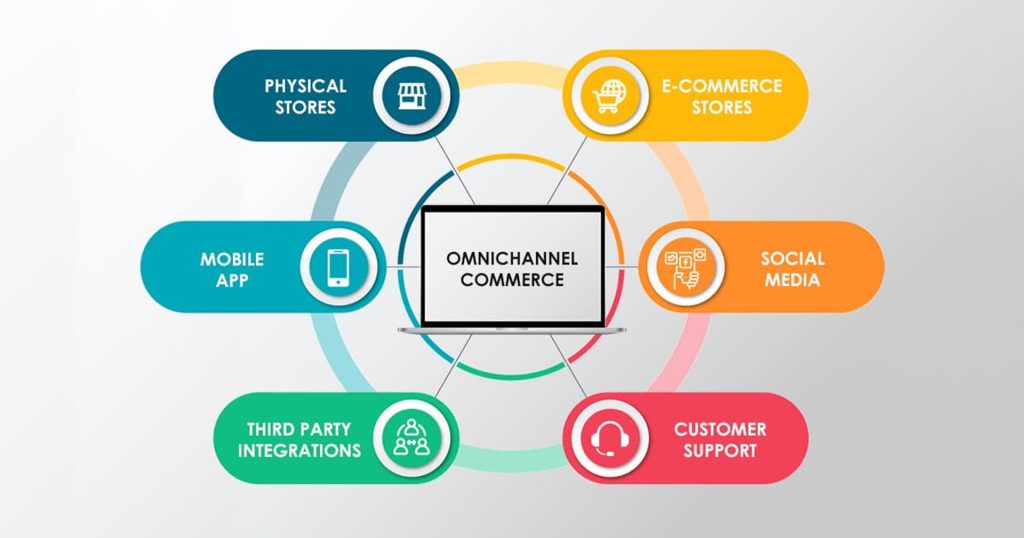
Source: XStak
The dictionary definition of ‘Omni’ is “a combining form meaning all.” Similarly, omnichannel eCommerce can be defined as the business practice or strategy that aims to provide a consistent shopping and interaction experience across all channels. Here, multiple channels are linked with each other for a cumulative approach.
As a result, customers get a unified brand experience across different mediums like physical stores, website, mobile app, social media, and so on. Irrespective of the platform they are on, customers’ journeys become seamless, and they are able to easily move ahead in the sales funnel. This makes omnichannel a win-win for both businesses and consumers.
Omnichannel eCommerce examples: Brands that are winning at it
The best way to understand omnichannel eCommerce is to look at the examples of brands that are following it. While omnichannel strategies have become common, some brands are exceeding expectations.
Here are some examples of brands that have implemented omnichannel strategies:
Starbucks
This multinational company gives goals to other brands when it comes to harnessing every digital opportunity that comes its way. The coffeehouse giant is winning at customer experience with the help of omnichannel presence. For instance, when Starbucks users pay for their coffee with their Starbucks card (physical or mobile), they win digital loyalty and reward points that they can view on the app.
Similarly, the Starbucks app allows customers to view an outlet near them, place advanced orders, and send gifts to their loved ones. Moreover, the Spotify integration allows users to view “Now Playing” and “Recently Played” music in Starbucks stores and add it to their personal playlists. Now how cool is that!
Sephora
Sephora is another brand that has championed omnichannel customer experience. The brand allows its customers to browse and view products online, check for product availability at nearby stores, take appointment-based virtual tutorials, book in-store services, and much more. They cleverly blend the physical and digital experience allowing a consistent experience for customers.
For instance, Sephora stores are highly powered with technology and help shoppers find the best products for them amidst thousands of options. Their Beauty Insider Rewards program allows customers to enjoy loyalty rewards across platforms. Their mobile app leverages location-based marketing to send relevant information and deals to users who visit a particular store, and so on.
Suggested Read: How to create an ecommerce shopping app like Amazon?
Omnichannel vs Multichannel: What is the difference?
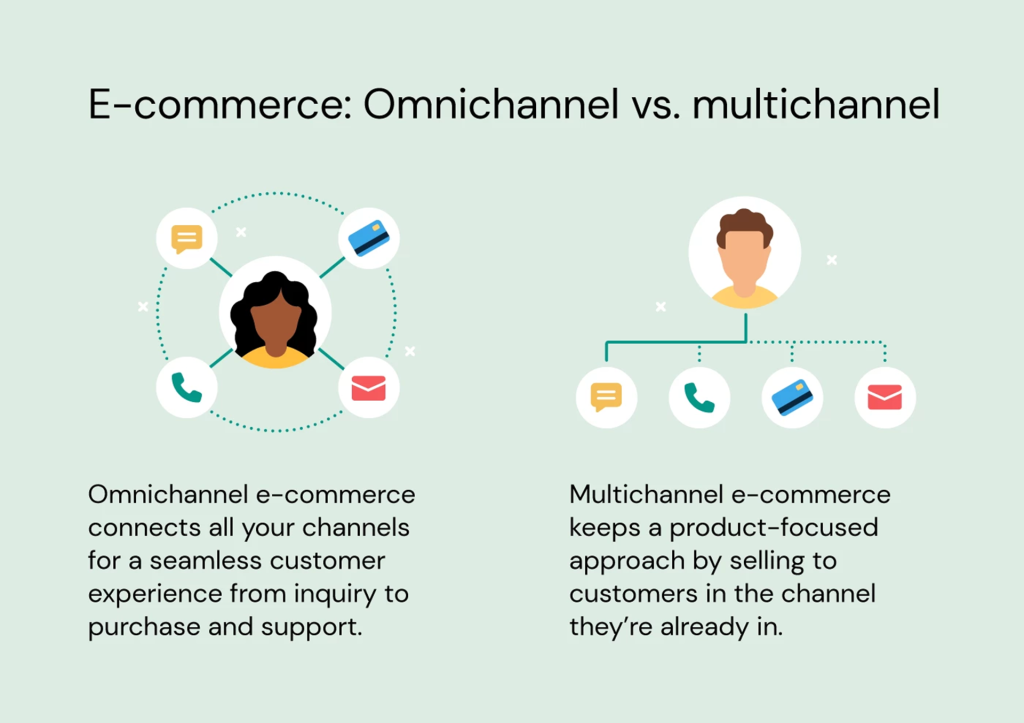
Source: Sinch
Many brands assume that they are offering an omnichannel experience just because they are present on multiple channels. However, this is not true. This is where the contrast between omnichannel and multichannel arises. Here’s how the two differ from each other:
Omnichannel eCommerce
Omnichannel eCommerce, as explained above, is when brands have an aggregated approach towards selling and customer journeys. Here, different platforms are interconnected in some way or the other, and customers are allowed to float between them seamlessly. Brands integrate important touchpoints and pave the way for a cohesive shopping experience based on centralized consumer data. For example, customers can view a product online and purchase it in the store while paying on through the store’s app.
Multichannel eCommerce
As the name suggests, multichannel eCommerce is where brands use multiple channels and platforms (physical store, website, app, social media, etc.) to reach customers. However, the brand tries to target the customer through the platform they are on. This is a siloed approach where one platform works in isolation with the other. For example, if the customer is on the social media channel of the brand and is interested in a product, they will have to open the website or app to purchase the product.
Evidently, multichannel eCommerce demands customers to put in more effort. On the contrary, omnichannel experience makes their journey smoother and frictionless, thereby proving to be a better strategy overall. As a result, more brands are moving towards omnichannel strategies for their business.
What are the benefits of implementing omnichannel eCommerce?
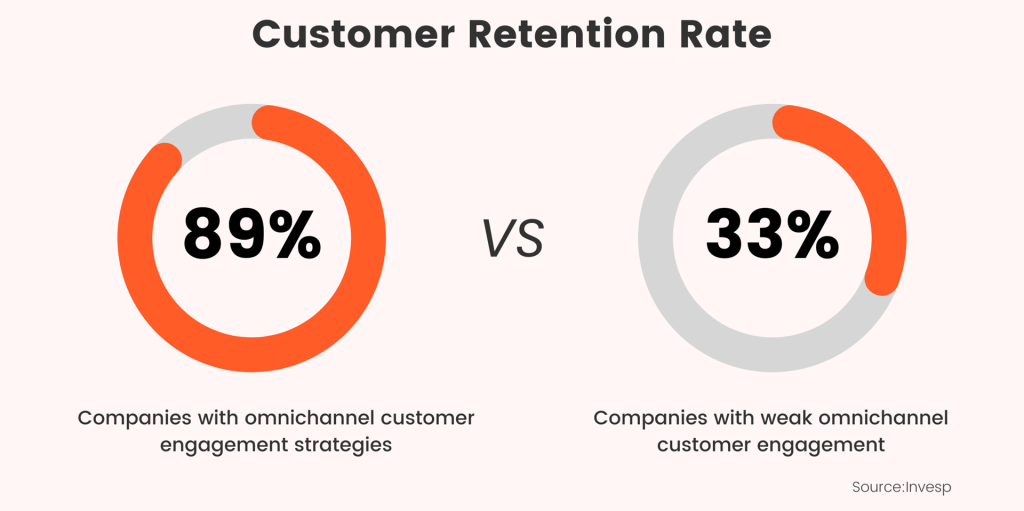
Source: Clerk.io
There are multiple advantages of implementing omnichannel strategies for your business. While it may be complex for some businesses to comprehend and implement it, the benefits make it worth the effort. It gives you an opportunity to reduce organizational silos and unify your services.
Go through the advantages of omnichannel eCommerce in detail below:
Elevated customer experience
The best thing about omnichannel eCommerce is that it makes customers feel entertained across all platforms. It allows them to start their purchase journey and get access to the required support through any medium. From interactive shopping to redeeming loyalty points, their journey becomes more optimized and frictionless.
Unified business processes
It is not just the customers that benefit from omnichannel eCommerce. The unified presence of brands across various mediums allows them to leverage every platform to its full potential. It becomes easier for them to integrate their workflows and assimilate data across platforms. As silos are eradicated, business processes become more systematic and cohesive.
Better insights and data collection
The power of data is not unknown to businesses of this day and age. As omnichannel eCommerce allows you to gather data from multiple sources in a unified manner, it ramps up your business and marketing game by several levels. You become capable of getting a high-level view of consumer’s journeys and generate actionable insights that favor your business decisions.
Higher sales and conversion
All that effort on enhancing and integrating customer journeys ultimately pays out in the form of better conversions. As customers enjoy a frictionless shopping tour, they are more likely to pay and convert. Average order value also increases for most customers. This gives a boost to all your performance metrics and leads to better revenue and earnings.
Increased customer loyalty and retention
Studies show that companies that have implemented omnichannel strategies enjoy 89 percent retention rate. Evidently, omnichannel approach ensures better customer loyalty, retention, and lifetime value (LTV) for your eCommerce business. This, in turn, leads to better performance and success and unlocks new growth opportunities for your brand.
In the United States, omnichannel shoppers have a 30% higher lifetime value than those who shop using only one channel, according to data from Harvard Business Review.
Suggested Read: Discover the advantages of Retention Marketing for eCommerce and make the most of it
How important are mobile apps in an omnichannel strategy?
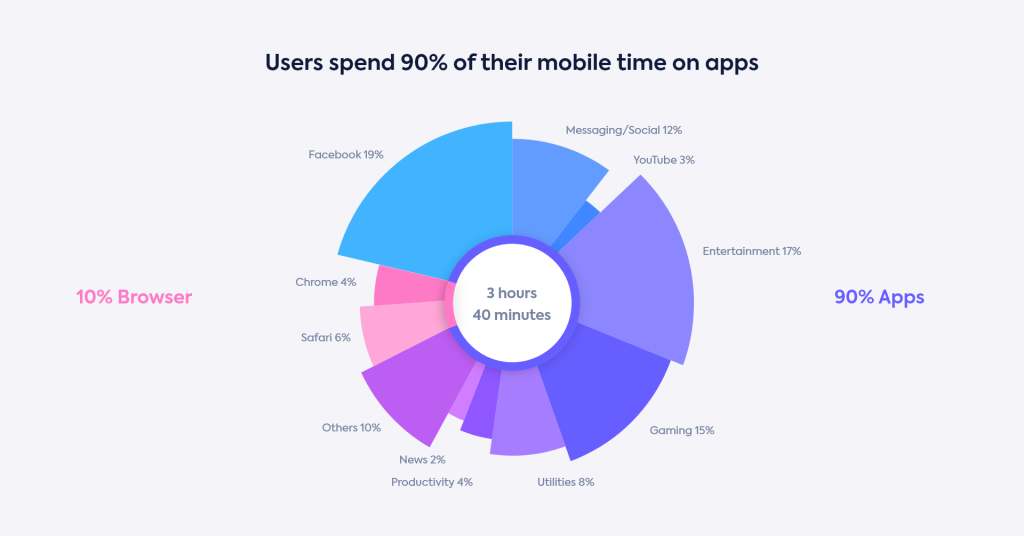
Source: ComScore
Omnichannel eCommerce incorporates various platforms and channels for a 360-degree approach. However, mobile apps have emerged as the most powerful tool for strengthening the all-inclusive approach for brands. This is because apps have become the go-to platform that is most preferred by users across the globe.
The number of online shoppers is growing by the second, compelling even physical stores like Sephora and Starbucks to go digital. Additionally, buyers spend most of their online time on mobile apps making them the most sought-after platform among businesses, marketers, advertisers, and sellers.
Statistics show that apps ensure better engagement, conversions, and communication across various online segments. Users find apps more convenient and it is also easier to collect user data through apps and personalize buyer journeys. Thus, mobile applications become a critical asset for brands that wish to leverage omnichannel eCommerce and win at it.
Apps can be seamlessly integrated with websites, social media channels, email, other marketing channels, and so on. This makes it easier for brands to implement omnichannel strategies while keeping apps at the forefront of their initiatives. Therefore, you must create an app for your eCommerce business and use it to the fullest potential.
Suggested Read: How to create an app? Make an app in ten simple steps.
How to create the best omnichannel eCommerce experience?
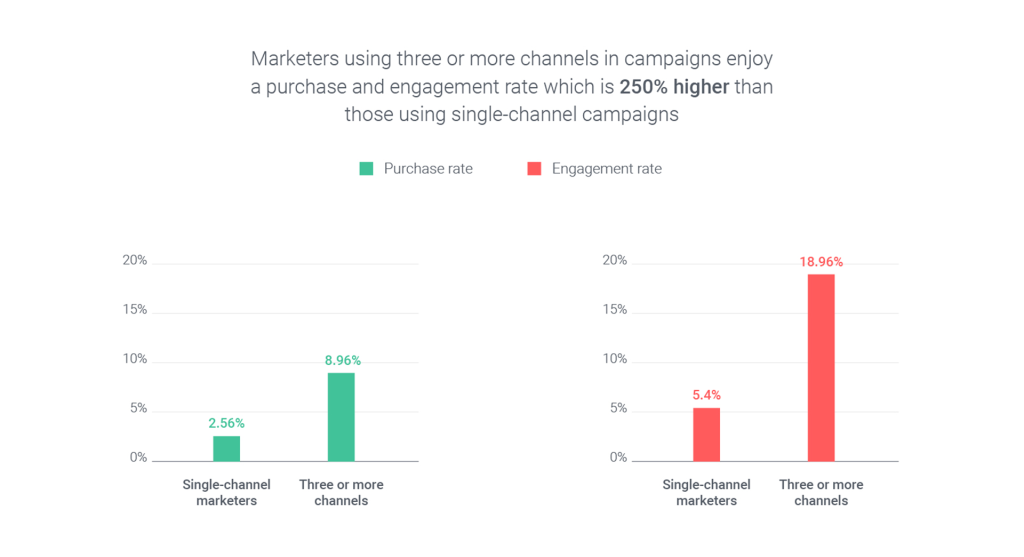
Source: Clickz
Understand your brand goals and target audience
Extensive research and planning are ideally the first steps for any new business initiative. Start with studying the market and researching your competitors and customers. You can create buyer personas to understand your targeted audience. Clearly outline your goals and create your strategies accordingly. Also, allocate a fixed amount of time and resources to avoid wasting effort and resources.
Map your customer journeys and collect data
Identifying customer touchpoints is mandatory for a robust omnichannel strategy. Map your customers’ journeys, both online and offline, and list their behavior and preferences. Use your existing data and collect new information from various channels to understand how customers interact with your brand.
Unify your platforms with omnichannel technologies
Invest in new platforms (websites, mobile apps, etc.) and tools (CMS, marketing, email automation, etc.) to ensure presence and communication across various platforms. Find reliable omnichannel technologies and proceed to unify your channels for a cohesive experience. Gather data and ensure availability for customers across various mediums.
Personalize and elevate customer experience
Use data to offer personalized recommendations and deals to customers across platforms. Make customer support an integral part of your omnichannel strategy through integrated chat and other similar features. Offer a matchless and consistent experience to customers irrespective of the medium and channel.
Extend omnichannel strategies to marketing
Do not limit your omnichannel strategies to buying and selling. Extend it to marketing and communication and use multiple channels for promotions and publicity. You can refer to the brand examples discussed at the start of the blog and take inspiration from them. Blend it with your own creativity and create winning marketing and sales strategies for your business.
Wrapping up
Overwhelmed by all the information? Relax! While omnichannel is a great strategy for eCommerce businesses, it is not the only way to succeed. If you are a small brand or a new business, it is important to move steadily and conquer one domain at a time.
For instance, if you have a physical store, you can proceed to build an eCommerce website using a platform like WooCommerce. Next, you can turn your WooCommerce website into an app and allow customers to launch your store with a click. Additionally, you can create social media accounts and connect them with your website and app.
Once you have ensured your presence across platforms, you can think of ways to link them and implement omnichannel eCommerce strategies. Focus on your brand goals and customer aspirations and plan around them. Keep an eye out for eCommerce trends and incorporate those strategies intuitively.
